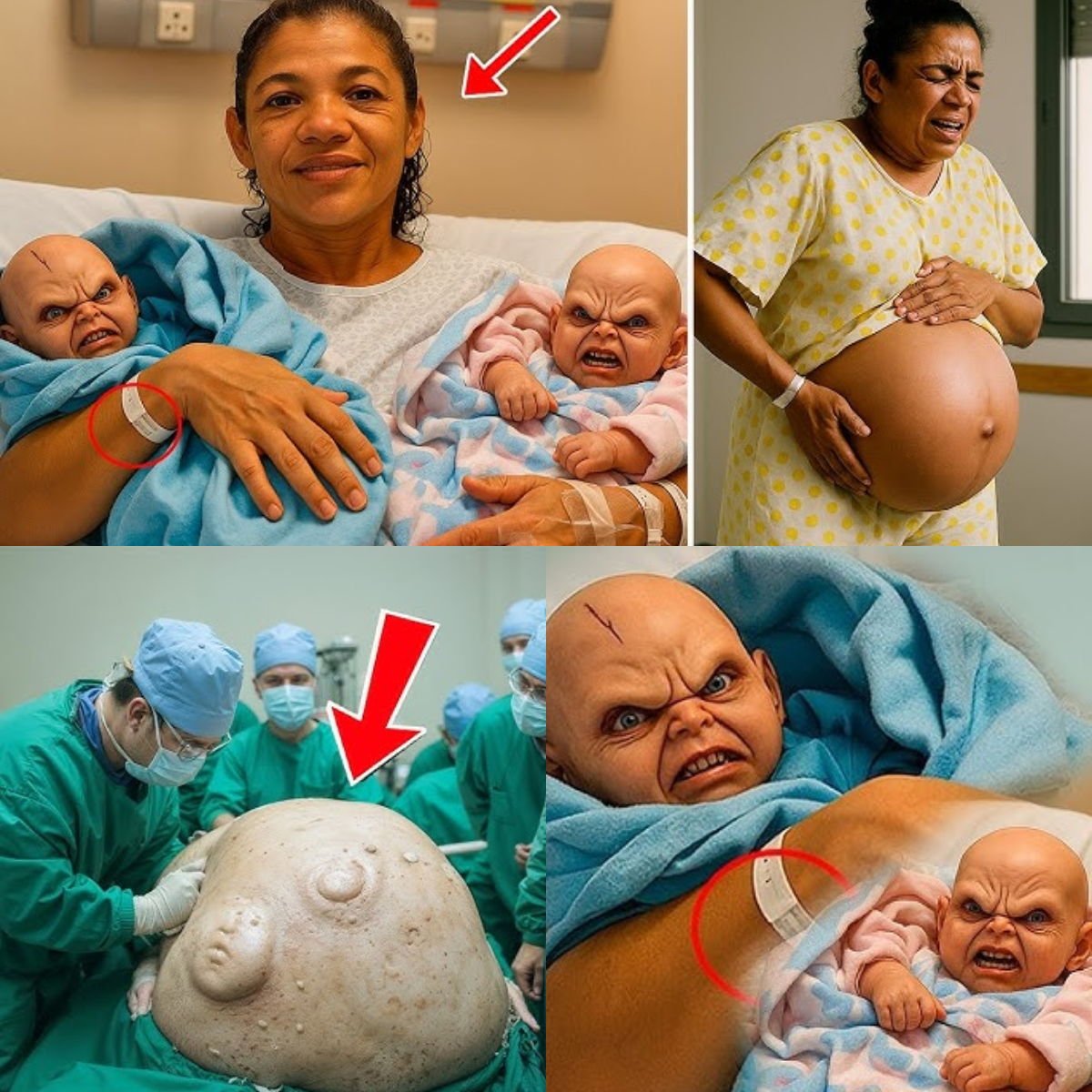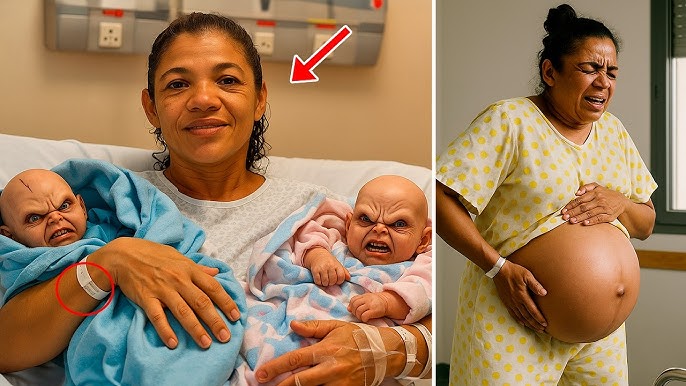The Day That Shattered Logic at St. Helena’s Hospital
At exactly 2:47 a.m., nurses at St. Helena’s Maternity Ward in San Diego rushed to prepare for what they believed was a complicated but normal delivery.
The expectant mother, Clara Evans, 33, had arrived earlier that evening complaining of severe abdominal pain and irregular contractions. Her husband, Daniel, stood pale beside her, clutching her hand as doctors prepped for an emergency C-section.
But when the first incision was made, and the operating room fell silent, every face froze.

Inside Clara’s womb—where they expected to deliver twins—they found something none of them had ever seen before:
Two eerily lifelike reborn dolls.
Perfectly formed.
Wrapped in miniature blankets.
Weighing almost the same as human infants.
It was as if someone had replaced her babies with porcelain replicas.
The senior obstetrician, Dr. Howard, later admitted:
“In my 25 years of practice, I’ve delivered over 3,000 babies. I have never—never—seen anything like this. It defied every medical explanation we know.”
The Startling Discovery
After the initial shock, nurses checked again. The ultrasound readings from the previous weeks had shown movement—heartbeats even.
But now, the monitors displayed nothing.
It was only after careful review that the truth began to unfold.

Clara had suffered from what doctors describe as a phantom twin syndrome combined with a rare psychosomatic pregnancy illusion—a psychological condition where the brain and body exhibit every symptom of pregnancy despite the absence of a viable fetus.
But this case had a disturbing twist: the dolls were not medical props. They were handcrafted reborn dolls — incredibly realistic, custom-made collectibles that Clara herself had ordered online months earlier.
And that revelation opened a story darker than anyone expected.
Who Is Clara Evans?

Before the bizarre birth, Clara had been a well-known nursery artist who created custom reborn dolls for grieving mothers — hyper-realistic baby sculptures that helped women cope with loss.
Her online page, “Forever Cradled Nursery,” had over 70,000 followers.
But beneath the soft pastels and gentle lullabies of her videos, something else was unraveling.
Three years earlier, Clara had lost real twins — Emma and Grace — in a car accident that also left her unable to conceive.
Her husband Daniel recalled:
“She never recovered. Every night, she’d sit in the nursery and talk to the air. I thought she was healing… but she was sinking.”
A Pregnancy No One Questioned
According to her family, Clara began claiming she was pregnant again eight months ago.
She posted pictures of her growing belly, ultrasound images, and even gender-reveal videos.
Her followers rejoiced.
Doctors confirmed her hormonal tests were positive.
Her stomach visibly swelled.
She even experienced real contractions.
No one doubted her.
Not even her husband.
Daniel whispered during an interview, his voice trembling:
“I felt them kick. I swear I did.”
The medical staff later confirmed that the movements were caused by gastric spasms and muscle tension — not fetal activity. But what puzzled them most was that Clara had somehow inserted the reborn dolls into her womb, using a method that remains medically unclear and potentially fatal.
The Chilling Truth
After the emergency surgery, investigators discovered hidden orders from overseas art vendors — two dolls crafted to look exactly like the twins Clara had lost.
The facial features, eye color, and even birthmarks matched.
Dr. Howard revealed:
“When we examined the dolls, we realized they were replicas — every detail mirrored the photos of her deceased babies. It was heartbreaking.”
Psychiatrists later determined that Clara’s trauma had reached a breaking point, leading her to create a “replacement pregnancy.” Her mind and body believed it so completely that her hormones changed to mimic real gestation.
One psychiatrist described it as:
“A tragedy born from grief — a mother so desperate to relive what she lost that her body obeyed her delusion.”
The Hospital’s Reaction
St. Helena’s immediately went into lockdown to prevent leaks. But within hours, an anonymous staff member posted on social media:
“A woman gave birth to two dolls. Everyone’s crying. No one can explain it.”
The post exploded.
By morning, #RebornBirth and #ClaraEvans were trending worldwide.
People demanded answers. Was it an elaborate hoax? A miracle? A psychological crisis?
The hospital released a short statement:
“We are aware of a highly unusual medical event involving a patient under treatment for trauma-related pregnancy symptoms. The patient is receiving compassionate care. No further details will be provided.”
Public Reaction: From Sympathy to Outrage
Social media divided instantly.
Some users mocked Clara, calling her “the doll mom who lost touch with reality.” Others defended her fiercely:
“This isn’t madness — it’s mourning.”
“You don’t understand what grief can make a mother do.”
Psychologists, trauma counselors, and even artists weighed in.
Dr. Fiona Morales, a grief therapist, said:
“Reborn dolls can be therapeutic — but they can also become dangerous if the illusion replaces reality.”
Meanwhile, doll artists flooded Clara’s page with compassion. One message read:
“We make dolls to heal, not to hide. May you find peace, Clara.”
Daniel’s Confession
Days later, Daniel broke his silence on national television.
In a trembling voice, he confessed:
“I knew she ordered dolls, but I didn’t think she’d do this. I should’ve stopped it. I just wanted her to smile again.”
He described how Clara had been withdrawn for months, sleeping beside the dolls and setting up two bassinets in the nursery.
“She called them by name,” he said. “She’d sing lullabies at night. When I tried to talk to her, she’d say, ‘They’re back, Daniel. Don’t you feel them?’”
The Experts Speak
Medical professionals worldwide have since studied the case as one of the most extreme manifestations of delusional pseudocyesis — a condition where the mind creates a full physiological pregnancy without conception.
What makes Clara’s case unique is the addition of the reborn dolls — a psychological bridge between loss and creation.
Dr. Elise Raymond, a London-based psychiatrist, summarized:
“This woman’s body did what her heart couldn’t: it made her grief tangible.”
She added that Clara’s story serves as both a warning and a mirror for how modern society underestimates trauma.
Aftermath and Recovery
Clara was placed under psychiatric observation following the incident. Her recovery is ongoing. Doctors say she alternates between lucidity and denial, often asking nurses, “Are my babies okay?”
Her husband visits daily, holding her hand through the fog of confusion.
“She still believes they’re alive,” Daniel whispered. “But maybe, in her mind, that’s the only way she can survive.”
Authorities have confirmed that no criminal charges will be filed, as there was no intent to deceive or harm.
Instead, Clara’s case is now used in psychological training programs across the U.S. — not as a spectacle, but as a study in compassion.
The Global Conversation It Sparked
Since the event, searches for “reborn therapy dolls” have skyrocketed. Hospitals are now discussing whether grief counseling should be mandatory after stillbirths and miscarriages.
A movement called #RealHealingNotReplacement has emerged, led by psychologists and mothers who advocate for emotional recovery instead of illusion.
One viral comment summed up the world’s heartbreak:
“She didn’t give birth to dolls. She gave birth to pain — shaped like love.”
Epilogue: Beyond Shock, a Lesson
As of this writing, Clara’s room at St. Helena’s remains filled with soft light and the faint scent of baby powder.
On her bedside table sit the two dolls — now dressed in matching blue knit hats. Nurses say she often hums lullabies to them.
Though her body has healed, her soul still lingers in that space between grief and belief.
And yet, those who have seen her up close agree on one thing:
She isn’t insane.
She’s broken — in a way that only love can break someone.
“Maybe,” Dr. Howard said quietly, “the real miracle isn’t that she carried dolls… it’s that her heart still believed she could love again.”
In the end, this wasn’t the story of a woman losing her mind.
It was the story of a mother whose love refused to die — even when reality did.
News
‘Kami-Kami Lang Talaga’: Rochelle Pangilinan Reveals Sexbomb Members Self-Funded Reunion Concert After Producer Rejection, Leading to Historic Sellout
Ang matagumpay na pagbabalik ng Sexbomb Girls sa entablado ng konsiyerto ay isang kultural na penomeno na nangibabaw sa social…
‘Walang Awa Grabe!’: Lumalalim ang Trahedya sa Pinansyal Nang Umano’y Inubos ni Lakam, Kapatid ni Kim Chiu, ang Ipon sa Bangko ni Daddy William
Ang salaysay ng kahirapan sa pananalapi at pagtataksil sa pamilya sa loob ng angkan ng Chiu, na nakasentro sa umano’y…
Kimpau Rumors Uminit: Kim Chiu at Paulo Avelino, Tinutukan ang “3 Years Na” Moment sa ABS-CBN Christmas Special
Nagkakagulo ang social media matapos kumalat ang usap-usapang “3 years na” raw sina Kim Chiu at Paulo Avelino—isang pahayag na…
Confirmed! Sikat na Aktres, Balik-Kapamilya sa Bagong Serye Matapos ang Matagal na Pagliban
Kumpirmado na ang matagal nang hinihintay ng maraming manonood: isang kilalang aktres ang muling magbabalik sa Kapamilya network para sa…
Surprising Truth? Jinkee Pacquiao’s Assistant Rebuts Rumors That Eman Was Abandoned by Manny Since Childhood
(From left) Jinkee Pacquiao, Manny Pacquiao, and Eman Bacosa Pacquiao. Images: Instagram/@jinkeepacquiao, @emanbacosapacquiao A personal assistant of Jinkee Pacquiao defended her and…
“A World-Shaking Reversal: Why Is the World Bank Almost Urging the Philippines to Borrow, While the Country Has Already Achieved 97% Digitalization and Financial Self-sufficiency?”
The international community and the domestic population are witnessing an unprecedented phenomenon in the nation’s financial history: a dramatic and…
End of content
No more pages to load












